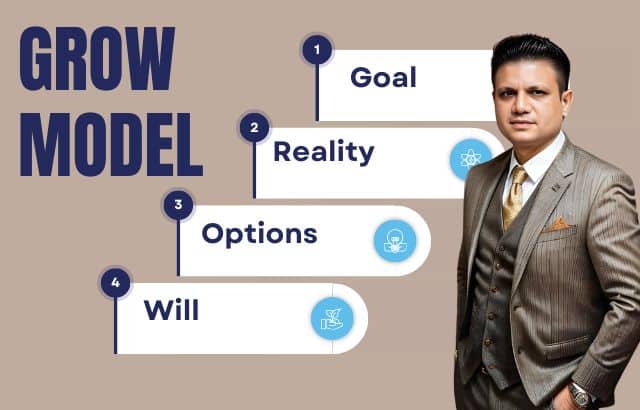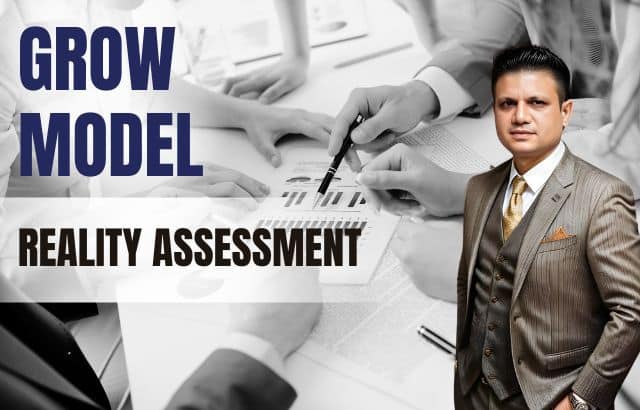In the pursuit of personal and professional growth, setting and achieving goals is paramount. However, without a structured approach, many individuals struggle to turn their aspirations into reality. Enter the GROW Model—an effective framework for goal setting and action planning. Let’s explore the GROW Model’s four components—Goal, Reality, Options, and Will (or Way Forward)—and learn how to apply them to achieve your goals with clarity and purpose.
Table of Contents
Goal:
What is Goal Setting?
Goal setting is the process of defining specific, measurable, achievable, relevant, and time-bound objectives that you aim to accomplish.
Why is Goal Setting Important?
Setting clear goals provides direction, motivation, and focus, guiding your actions and decisions towards desired outcomes. It helps you clarify your priorities, track progress, and stay accountable.
What Strategies Can You Use for Goal Setting?
Define SMART Goals: Ensure your goals are Specific, Measurable, Achievable, Relevant, and Time-bound.
Visualize Success: Create a vivid mental image of achieving your goals to enhance motivation and commitment.
Break It Down: Divide larger goals into smaller, manageable tasks to make progress more achievable and trackable.
Write It Down: Document your goals in writing to solidify your commitment and serve as a reference point for action.
How Can You Execute Goal Setting?
Set Clear Objectives: Clearly articulate what you want to achieve, why it’s important, and by when.
Develop Action Plans: Identify specific steps, resources, and timelines needed to reach your goals.
Monitor Progress: Regularly review your goals, track progress, and adjust your action plans as needed.
Celebrate Milestones: Acknowledge and celebrate your achievements along the way to maintain motivation and momentum.
Exercise for Goal Setting:
Define Your Goal: Let’s say your goal is to improve your physical fitness by running a 5k race within the next three months.
Reality Check: Currently, you’re able to run 2 kilometers comfortably, but you struggle with endurance and pacing during longer runs. You also have a busy schedule that makes it challenging to find time for consistent training.
Explore Options: You could explore options such as following a structured training plan, joining a running group for accountability and support, or hiring a personal trainer to provide guidance and motivation.
Determine Will or Way Forward: You decide to commit to a training plan that includes gradually increasing your mileage, incorporating interval training to improve endurance, and scheduling runs early in the morning or during lunch breaks to accommodate your busy schedule.
Reality:
What is Reality Assessment?
Reality assessment involves evaluating your current situation, strengths, weaknesses, opportunities, and threats in relation to your goals.
Why is Reality Assessment Important?
Assessing reality provides clarity and awareness of your starting point, enabling you to identify potential obstacles, leverage strengths, and capitalize on opportunities for growth.
What Strategies Can You Use for Reality Assessment?
Reflect Honestly: Take an honest inventory of your current skills, resources, and limitations.
Seek Feedback: Solicit input from trusted mentors, peers, or coaches to gain valuable perspectives on your strengths and areas for improvement.
Analyze Trends: Review past performance, trends, and patterns to identify what has worked well and what needs improvement.
Conduct SWOT Analysis: Evaluate your Strengths, Weaknesses, Opportunities, and Threats to gain insights into your current reality.
How Can You Execute Reality Assessment?
Conduct Self-Reflection: Set aside time to reflect on your goals, values, and priorities to gain clarity on what matters most to you.
Gather Data: Collect relevant information, data, and feedback to assess your current situation accurately.
Identify Barriers: Identify potential obstacles, challenges, and limitations that may hinder your progress towards your goals.
Create an Action Plan: Based on your reality assessment, develop strategies to leverage strengths, address weaknesses, and capitalize on opportunities.
Exercise for Reality Assessment:
Define Your Current Situation: You’re currently working a demanding job with long hours and limited flexibility for personal activities like exercise.
Goal Alignment: Your goal of running a 5k race aligns with your desire to improve your physical health and overall well-being, but your current work schedule poses a challenge.
Explore Options: You could explore options such as negotiating a more flexible work schedule, finding ways to incorporate physical activity into your daily routine, or seeking support from colleagues or family members.
Determine Will or Way Forward: You decide to talk to your supervisor about adjusting your work hours to allow for regular exercise, and you commit to prioritizing your health by scheduling workouts before or after work and on weekends.
Options:
What are Options?
Options refer to the various strategies, approaches, and alternatives available to you for achieving your goals.
Why are Options Important?
Exploring options expands your perspective, creativity, and problem-solving skills, enabling you to consider alternative pathways to success and overcome obstacles more effectively.
What Strategies Can You Use for Generating Options?
Brainstorm Ideas: Generate a wide range of potential solutions, without judgment or limitation, to stimulate creativity and innovation.
Seek Inspiration: Draw inspiration from diverse sources, such as books, articles, case studies, or conversations with peers, to explore new ideas and perspectives.
Consider Multiple Perspectives: Put yourself in the shoes of different stakeholders and consider their viewpoints, preferences, and priorities when evaluating options.
Prioritize Criteria: Establish criteria or criteria for evaluating options based on factors such as feasibility, impact, cost, and alignment with your goals and values.
How Can You Execute Generating Options?
Generate Ideas: Set aside dedicated time for brainstorming and idea generation, using techniques such as mind mapping, journaling, or group discussions.
Evaluate Alternatives: Assess the pros and cons of each option based on your established criteria, considering factors such as feasibility, potential impact, and alignment with your goals.
Select the Best Fit: Choose the option or combination of options that best aligns with your goals, values, and priorities, and has the highest likelihood of success.
Develop Action Plans: Create detailed action plans for implementing your chosen options, including specific steps, resources, and timelines.
Exercise for Generating Options:
Brainstorm Potential Solutions: You brainstorm potential solutions such as joining a gym, hiring a personal trainer, signing up for fitness classes, or following online workout programs.
Assess Feasibility: After evaluating each option based on factors like cost, convenience, and effectiveness, you determine that joining a gym and following a structured workout plan is the most feasible and sustainable approach for you.
Narrow Down Choices: You narrow down your options to joining a local gym that offers a variety of fitness classes and equipment, as well as flexible hours to accommodate your schedule.
Determine Will or Way Forward: You decide to join the gym and commit to attending classes three times a week, incorporating strength training and cardiovascular exercises into your routine, and tracking your progress to stay motivated and accountable.
Will (or Way Forward):
What is Will (or Way Forward)?
Will, or Way Forward, involves committing to specific actions and strategies for implementing your chosen options and achieving your goals.
Why is Will (or Way Forward) Important?
Willpower and commitment are essential for translating ideas into action, overcoming obstacles, and staying focused and motivated on your journey towards goal achievement.
What Strategies Can You Use for Will (or Way Forward)?
Set Clear Intentions: Clarify your intentions and motivations for pursuing your goals, anchoring them in your values and aspirations.
Cultivate Resilience: Develop resilience and perseverance to overcome setbacks, challenges, and failures along the way.
Foster Accountability: Hold yourself accountable for your actions and progress by setting deadlines, milestones, and checkpoints for tracking your performance.
Stay Flexible: Remain adaptable and open to adjusting your plans as needed based on feedback, changing circumstances, and new information.
How Can You Execute Will (or Way Forward)?
Commit to Action: Make a firm commitment to taking action by setting specific goals, deadlines, and milestones for achieving your desired outcomes.
Stay Motivated: Keep yourself motivated and focused on your goals by regularly reminding yourself of your reasons for pursuing them and visualizing your success.
Monitor Progress: Track your progress towards your goals regularly, adjusting your plans and strategies as needed to stay on track and overcome obstacles.
Celebrate Achievements: Celebrate your successes and milestones along the way, no matter how small, to reinforce positive habits and maintain momentum.
Exercise for Will (or Way Forward):
Clarify Commitment: You reaffirm your commitment to improving your physical fitness by setting specific goals, such as increasing your running distance and improving your overall endurance.
Overcome Obstacles: You anticipate potential obstacles such as fatigue, lack of motivation, and busy work schedules, but you develop strategies to overcome them, such as setting realistic goals, seeking support from friends and family, and scheduling workouts in advance.
Build Support: You enlist the support of a workout buddy, join online fitness communities for motivation and accountability, and seek guidance from fitness professionals to ensure you stay on track.
Take Action: You take decisive action by following your training plan, attending gym classes regularly, and making healthy lifestyle choices such as eating nutritious meals and getting enough rest and recovery. You monitor your progress and adjust your approach as needed to continue moving closer to your goal of running a successful 5k race.
Conclusion:
In conclusion, the GROW Model provides a powerful framework for setting and achieving goals with clarity, purpose, and effectiveness. By following the four components—Goal, Reality, Options, and Will (or Way Forward)—individuals can gain clarity on their objectives, assess their current situation, explore alternative strategies, and commit to specific actions for success. Through reflection, strategic planning, execution, and perseverance, the GROW Model empowers individuals to unlock their full potential and realize their aspirations in both personal and professional domains. So, embrace the GROW Model, and embark on your journey towards achieving your goals with confidence and determination.


























